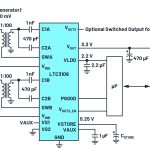By Bruce Haug, Senior Product Marketing Engineer, Power by Linear, Analog Devices
The proliferation of ultralow power wireless sensor nodes (WSN) for measurement and control, along with transducer technology advances, has made it possible to produce completely autonomous systems that are powered by local ambient energy instead of a primary or secondary battery. Powering a WSN from an ambient or “free” energy source is attractive because it can supplement or eliminate the need for batteries or wires. This is a clear benefit when battery replacement or servicing is inconvenient, labour-intensive and costly.
Wire elimination also makes it easy to expand monitoring and control systems on a large scale. Energy-harvesting wireless sensor systems simplify the installation and maintenance in diverse areas such as asset tracking, structural health monitoring (bridges, pipelines, railways, roads, etc.), agriculture and factory automation (process control, machine health monitoring, etc.), and others.
The best-known energy-harvesting collectors are large solar panels and wind generators, which have become major alternative energy sources for the power grid. But small embedded devices can also rely on energy-scavenging systems that can capture milliwatts of power from light, vibration, thermal and even biological sources. The closer an energy-harvesting device is to supplying the overall demands of an embedded system, the closer the system is to autonomous operation without a battery.










